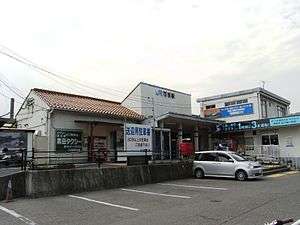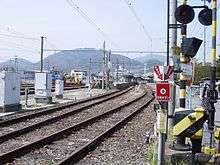Kabe Station (Hiroshima)
Kabe Station (可部駅, Kabe-eki) is a railway station on the Kabe Line in Asakita-ku, Hiroshima, Hiroshima Prefecture, Japan.[1] It is operated by the West Japan Railway Company (JR West). From December 1, 2003 to March 4, 2017, it was the terminal station of the Kabe Line.
Kabe Station 可部駅 | |
|---|---|
 Kabe Station building in July 2008 | |
| Location | 2 Chome-27 Kabe, Asakita-ku, Hiroshima-shi Japan |
| Coordinates | 34.512728°N 132.510711°E |
| Operated by | |
| Line(s) | B Kabe Line |
| Tracks | 2 |
| Other information | |
| Website | Official website |
| History | |
| Opened | July 13, 1911 |
| Traffic | |
| Passengers (FY2015) | 3,665 daily |
| Location | |
 Kabe Station Location within Japan | |
Station layout


Kabe Station has two side platforms handling two tracks. Before the extension to Aki-Kameyama Station, the station handled three tracks. Tracks one and two were bay platforms, and handled trains heading towards Hiroshima Station. The third track was bidirectional, and also led towards the abandoned portion of the Kabe line.
Toilet facilities
Prior to 2006, a unisex restroom was located outside the station before passing through the ticket gates. While the station is within the city of Hiroshima, this restroom featured a pit-style toilet which had to be pumped regularly in order to remove the accumulated waste. The station had developed somewhat of a bad reputation because of this due to the lingering odor. This issue was resolved in 2006 with the replacement of gender-specific restrooms featuring standard flush toilets connected to the city's sewer system.
Adjacent stations
| « | Service | » | ||
|---|---|---|---|---|
| Kabe Line | ||||
| Nakashima | Local | Kōdo-Homachigawa | ||
| Kabe Line (former) | ||||
| Nakashima | Local | Kōdo | ||
History
- 1911-07-13: Kobe Station opens
- 1919-03-11: The station becomes part of Kabe Railroad
- 1926-05-01: Kabe Railroad merges with Hiroshima Denki and the station ownership is transferred with the merger
- 1928-11-09: Service from Furuichibashi Station is suspended while track electrification takes place, buses handles service during this time
- 1929-12-02: Service begins again after the completion of the electrification work
- 1931-07-01: The station becomes part of Kōhama Railway
- 1935-12-01: The station is renamed Kōhama Kabe Station
- 1936-09-01: The station is renamed Kabe Station when it is nationalized
- 1936-10-13: The line between Aki-Imuro Station and Kabe Station is opened, making Kabe Station an intermediate station
- 1987-04-01: Japanese National Railways is privatized, and Kabe Station becomes a JR West station
- 2003-12-01: Service on the 46.2 km non-electrified rail line segment from Kabe Station to Sandankyō Station is suspended, making Kabe Station the terminal station of the Kabe Line
- 2017-03-04: Kabe Station ceases to be the terminus of the Kabe Line after a 1.6 km electrified extension to Aki-Kameyama opens, platform three closes
Surrounding area

- Hiroshima Municipal Kabe Minami Elementary School
- Hiroshima Municipal Kabe High School
- Hiroshima Bunkyo Women's University
- Kabe Station Entrance Bus Station
- Kabe Driving School
- Kabe Public Employment Office
- Doi Clinic
- Ōta River
- JR West Geibi Line Shimofukawa Station is located 1.5 km southwest
See also
References
- 可部線 可部駅 (in Japanese). 2002-10-12. Retrieved 2007-01-30.
External links
| Wikimedia Commons has media related to Kabe Station (Hiroshima). |
- Official website (in Japanese)